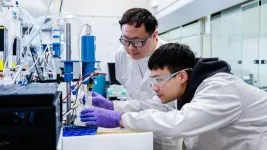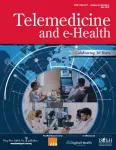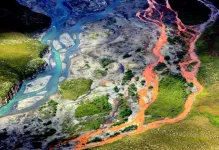(Press-News.org) A low-cost, tin-based catalyst can selectively convert carbon dioxide to three widely produced chemicals — ethanol, acetic acid and formic acid.
Lurking within the emissions from many industrial operations is an untapped resource — carbon dioxide (CO2). A contributor of greenhouse gas and global warming, it could instead be captured and converted to value-added chemicals.
In a collaborative project involving the U.S. Department of Energy’s (DOE) Argonne National Laboratory, Northern Illinois University and Valparaiso University, scientists report a family of catalysts that efficiently converts CO2 into ethanol, acetic acid or formic acid. These liquid hydrocarbons are among the most produced chemicals in the U.S. and are found in many commercial products. For example, ethanol is a key ingredient in numerous household products and an additive to nearly all U.S. gasoline.
The catalysts are based on tin metal deposited over a carbon support. “If fully developed, our catalysts could convert the CO2 produced at various industrial sources to valuable chemicals,” said Di-Jia Liu. “These sources include fossil fuel power plants and bio-fermentation and waste treatment facilities.” Liu is a senior chemist at Argonne and a senior scientist in the Pritzker School of Molecular Engineering at the University of Chicago.
“Our finding of a changing reaction path by the catalyst size is unprecedented.” — Di-Jia Liu, senior chemist
The method used by the team is called electrocatalytic conversion, meaning that CO2 conversion over a catalyst is driven by electricity. By varying the size of tin used from single atoms to ultrasmall clusters and also to larger nano-crystallites, the team could control the CO2 conversion to acetic acid, ethanol and formic acid, respectively. Selectivity for each of these chemicals was 90% or higher. “Our finding of a changing reaction path by the catalyst size is unprecedented,” Liu said.
Computational and experimental studies revealed several insights into the reaction mechanisms forming the three hydrocarbons. One important insight was that the reaction path completely changes when the ordinary water used in the conversion is switched to deuterated water (deuterium is an isotope of hydrogen). This phenomenon is known as the kinetic isotope effect. It has never been previously observed in CO2 conversion.
This research benefited from two DOE Office of Science user facilities at Argonne — the Advanced Photon Source (APS) and Center for Nanoscale Materials (CNM). “Using the hard X-ray beams available at the APS, we captured the chemical and electronic structures of the tin-based catalysts with different tin loadings,” said Chengjun Sun, an Argonne physicist. In addition, the high spatial resolution possible with a transmission electron microscope at CNM directly imaged the arrangement of tin atoms, from single atoms to small clusters, with the different catalyst loadings.
According to Liu, “Our ultimate goal is to use locally generated electricity from wind and solar to produce desired chemicals for local consumption.”
This would require integrating the newly discovered catalysts into a low-temperature electrolyzer to carry out the CO2 conversion with electricity supplied by renewable energy. Low-temperature electrolyzers can operate at near ambient temperature and pressure. This allows rapid start and stop to accommodate the intermittent supply of renewable energy. It is an ideal technology to serve this purpose.
“If we can selectively produce only the chemicals in need near the site, we can help to cut down on CO2 transport and storage costs,” Liu noted. “It would truly be a win-win situation for local adopters of our technology.”
The corresponding scientific paper appeared in the Journal of the American Chemical Society. In addition to Di-Jia Liu and Chengjun Sun, authors include Haiping Xu, Jianxin Wang, Haiying He, Inhui Hwang, Yuzi Liu, Haozhe Zhang, Tao Li, John V. Muntean and Tao Xu.
Support for the research came from DOE’s Office of Energy Efficiency and Renewable Energy under the Advanced Manufacturing Office, Industrial Efficiency & Decarbonization Office. Additional support was provided by Argonne’s Laboratory Directed Research and Development fund.
About Argonne’s Center for Nanoscale Materials
The Center for Nanoscale Materials is one of the five DOE Nanoscale Science Research Centers, premier national user facilities for interdisciplinary research at the nanoscale supported by the DOE Office of Science. Together the NSRCs comprise a suite of complementary facilities that provide researchers with state-of-the-art capabilities to fabricate, process, characterize and model nanoscale materials, and constitute the largest infrastructure investment of the National Nanotechnology Initiative. The NSRCs are located at DOE’s Argonne, Brookhaven, Lawrence Berkeley, Oak Ridge, Sandia and Los Alamos National Laboratories. For more information about the DOE NSRCs, please visit https://science.osti.gov/User-Facilities/User-Facilities-at-a-Glance.
About the Advanced Photon Source
The U. S. Department of Energy Office of Science’s Advanced Photon Source (APS) at Argonne National Laboratory is one of the world’s most productive X-ray light source facilities. The APS provides high-brightness X-ray beams to a diverse community of researchers in materials science, chemistry, condensed matter physics, the life and environmental sciences, and applied research. These X-rays are ideally suited for explorations of materials and biological structures; elemental distribution; chemical, magnetic, electronic states; and a wide range of technologically important engineering systems from batteries to fuel injector sprays, all of which are the foundations of our nation’s economic, technological, and physical well-being. Each year, more than 5,000 researchers use the APS to produce over 2,000 publications detailing impactful discoveries, and solve more vital biological protein structures than users of any other X-ray light source research facility. APS scientists and engineers innovate technology that is at the heart of advancing accelerator and light-source operations. This includes the insertion devices that produce extreme-brightness X-rays prized by researchers, lenses that focus the X-rays down to a few nanometers, instrumentation that maximizes the way the X-rays interact with samples being studied, and software that gathers and manages the massive quantity of data resulting from discovery research at the APS.
This research used resources of the Advanced Photon Source, a U.S. DOE Office of Science User Facility operated for the DOE Office of Science by Argonne National Laboratory under Contract No. DE-AC02-06CH11357.
Argonne National Laboratory seeks solutions to pressing national problems in science and technology by conducting leading-edge basic and applied research in virtually every scientific discipline. Argonne is managed by UChicago Argonne, LLC for the U.S. Department of Energy’s Office of Science.
The U.S. Department of Energy’s Office of Science is the single largest supporter of basic research in the physical sciences in the United States and is working to address some of the most pressing challenges of our time. For more information, visit https://energy.gov/science.
END
Recycling carbon dioxide into household chemicals
New catalyst transforms carbon dioxide from industrial emissions into commonly used chemicals
2024-05-21
ELSE PRESS RELEASES FROM THIS DATE:
Wayne State faculty member named president of the International Association for Great Lakes Research board
2024-05-21
DETROIT —
The International Association for Great Lakes Research today announced its new board of directors and has named Donna Kashian, Ph.D., professor of biological sciences and director of environmental sciences in the College of Liberal Arts and Sciences at Wayne State University, as president. Kashian previously served as vice president of the board.
Founded in 1967, the International Association for Great Lakes Research is a scientific organization made up of researchers studying the Laurentian Great Lakes, other large lakes of the world and their watersheds, as well as those ...
Consultative support to pediatric primary care providers in providing gender-affirming care
2024-05-21
New Rochelle, NY, May 21, 2024—A new study in the peer-reviewed journal Telemedicine and e-Health found that access to consultative support can increase pediatric primary care provider comfort providing gender-affirming care. Click here to read the article now.
The literature suggests that access to gender-affirming medical care is associated with improved medical outcomes among adolescents who identify as gender diverse or endorse a gender identity that differs from their sex assigned at birth. An increasing number of gender diverse youth seek guidance and support from their pediatric primary care providers (PPCPs), who often lack adequate training in this ...
Alaska’s rusting waters: Pristine rivers and streams turning orange
2024-05-21
Dozens of Alaska’s most remote streams and rivers are turning from a crystal clear blue into a cloudy orange, and the staining could be the result of minerals exposed by thawing permafrost, new research in the Nature journal Communications: Earth and Environment finds.
For the first time, a team of researchers from the National Park Service, U.S. Geological Survey, the University of California, Davis, and other institutions have documented and sampled some of the impaired waters, pinpointing ...
Jefferson Lab director named to 2024 Hampton Roads Power List
2024-05-21
NEWPORT NEWS, VA – Stuart Henderson, director of the U.S. Department of Energy's Thomas Jefferson National Accelerator Facility, has been named to the Hampton Roads Power List by Inside Business. The list recognizes the major players in Hampton Roads’ economy. According to Inside Business, the 2024 list considered milestones and current events, and it features “the talk of Hampton Roads and the change that’s coming.”
“I am honored to be included in this list of people who are moving Hampton ...
New crystal production method could enhance quantum computers and electronics
2024-05-21
Irvine, Calif., May 21, 2024 — In a study published in Nature Materials, scientists from the University of California, Irvine describe a new method to make very thin crystals of the element bismuth – a process that may aid the manufacturing of cheap flexible electronics an everyday reality.
“Bismuth has fascinated scientists for over a hundred years due to its low melting point and unique electronic properties,” said Javier Sanchez-Yamagishi, assistant professor of physics & astronomy at UC Irvine and a co-author of the study. “We developed a new method to make very thin crystals ...
Inherited genes play a larger role in melanoma risk than previously believed
2024-05-21
CLEVELAND - When it comes to skin cancer, most people think of warnings about sunburn and tanning beds. Thoughts of “cancer genes” or inherited risks are reserved for diseases like breast cancer or colon cancer. A new study challenges this status quo by showing that genetics play a larger role in melanoma risk than recognized.
Physicians rarely order genetic screens to assess risk factors for patients with a family history of melanoma because, according to the previous, limited studies, only 2-2.5% of all cases are genetic. For the same reason, insurance companies rarely cover these tests outside of the most extreme ...
Two promising UCF researchers earn 2024 NSF CAREER Awards
2024-05-21
Two Promising UCF Researchers Earn 2024 NSF CAREER Awards
Early-career professors Fan Yao and Li Fang are receiving significant research funding to continue catalyzing their work as part of an annual NSF grant program.
By Eddy Duryea ’13
ORLANDO, May 21, 2024 – UCF assistant professors Li Fang and Fan Yao have been named 2024 U.S. National Science Foundation (NSF) Faculty Early Career Development program (CAREER) award winners. The recipients were awarded funding through five years for their submitted projects.
Fang, who is an assistant professor in UCF’s Department of Physics within the College of Sciences, is using the ...
Study comparing U-M Weight Navigation Program with usual care for high-risk patients shows higher use of evidence-based treatments and more weight lost
2024-05-21
Giving high-risk patients access to an obesity specialist through their regular primary care clinic increased their chances of receiving at least one evidence-based weight-management treatment, and led to more weight lost in just a year, a new University of Michigan study finds.
Primary care clinicians commonly struggle to help patients develop an individualized weight-management treatment plan during short clinic visits. Previous U-M research showed that most primary care patients with ...
Stuart Orkin awarded the Shaw Prize in Life Science & Medicine 2024 for groundbreaking hemoglobin research
2024-05-21
[BOSTON, MAY 21, 2024] – Stuart Orkin, MD, a researcher at the Dana-Farber/Boston Children's Cancer and Blood Disorders Center and David G. Nathan Distinguished Professor of Pediatrics at Harvard Medical School, has been honored with The Shaw Prize in Life Science & Medicine for his pioneering work discovering the genetic and molecular mechanisms underlying the switch from fetal to adult hemoglobin. Dr. Orkin shares the prize with Swee Lay Thein, PhD, Senior Investigator and Chief of the Sickle Cell Branch of National Heart, ...
Drug-like inhibitor shows promise in preventing flu
2024-05-21
LA JOLLA, CA—Currently available flu medications only target the virus after it has already established an infection, but what if a drug could prevent infection in the first place? Now, scientists at Scripps Research and the Albert Einstein College of Medicine have designed drug-like molecules to do just that, by thwarting the first stage of influenza infection.
The drug-like inhibitors block the virus from entering the body’s respiratory cells—specifically, they target hemagglutinin, a protein on the surface of type A influenza viruses. The findings, published in the Proceedings of the National Academy of Sciences ...
LAST 30 PRESS RELEASES:
SwRI upgrades nuclear magnetic resonance laboratory for pharmaceutical R&D
House sparrows in northern Norway can help us save other endangered animals
Crohn's & Colitis Foundation survey reveals more than 1/3 of young adults with IBD face step therapy insurance barriers
Tethered UAV autonomous knotting on environmental structures for transport
Decentralized social media platforms unlock authentic consumer feedback
American Pediatric Society announces Vanderbilt University School of Medicine as host institution for APS Howland Visiting Professor Program
Scientists discover first method to safely back up quantum information
A role for orange pigments in birds and human redheads
Pathways to net-zero greenhouse gas emissions for Southeast Asia
A JBNU–KIMS collaborative study on a cost-effective alloy matches superalloys for power plants and energy infrastructure
New study overturns long-held model of how plants coordinate immune responses.
New AI model predicts disease risk while you sleep
Scientists discover molecular ‘reshuffle’ and crack an 80-year-old conundrum
How stressors during pregnancy impact the developing fetal brain
Electrons lag behind the nucleus
From fungi to brain cells: one scientist's winding path reveals how epigenomics shapes neural destiny
Schizophrenia and osteoporosis share 195 genetic loci, highlighting unexpected biological bridges between brain and bone
Schizophrenia-linked genetic variant renders key brain receptor completely unresponsive to both natural and therapeutic compounds
Innovative review reveals overlooked complexity in cellular energy sensor's dual roles in Alzheimer's disease
Autism research reframed: Why heterogeneity is the data, not the noise
Brazil's genetic treasure trove: supercentenarians reveal secrets of extreme human longevity
The (metabolic) cost of life
CFRI special issue call for papers: New Frontiers in Sustainable Finance
HKU Engineering scholar demonstrates the smallest all-printed infrared photodetectors to date
Precision empowerment for brain "eavesdropping": CAS team develops triple-electrode integrated functional electrode for simultaneous monitoring of neural signals and chemical transmitters during sleep
Single-capillary endothelial dysfunction resolved by optoacoustic mesoscopy
HKU three research projects named among ‘Top 10 Innovation & Technology News in Hong Kong 2025’ showcasing excellence in research and technology transfer
NLRSeek: A reannotation-based pipeline for mining missing NLR genes in sequenced genomes
A strand and whole genome duplication–aware collinear gene identification tool
Light storage in light cages: A revolutionary approach to on-chip quantum memories
[Press-News.org] Recycling carbon dioxide into household chemicalsNew catalyst transforms carbon dioxide from industrial emissions into commonly used chemicals





